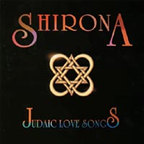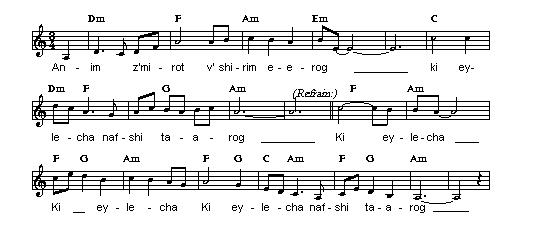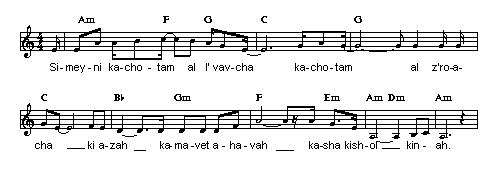A New Liturgical Voice
a review of the album by Shirona: "Judaic Love Songs"
Reviewed by Cantor Sam Weiss
This page is based on an article in Volume XXVIII of The Journal of Synagogue Music, published by The Cantors Assembly.

Shirona
Judaic Love Songs, 2000
For further info, visit www.shirona.com.
Today's Jewish musical culture abounds in the singing of liturgical texts. In services, concerts, youth-group meetings, school programs, and summer camps, congregations and audiences are singing out loud words from the Siddur and the Torah, while the boundaries between worship and entertainment are becoming more fluid than ever.
Singers who join liturgical texts to song can take two approaches. One is to start with an inspirational melody or composition and fuse it to an appropriate text. In the last two centuries this approach has been best exemplified in the Ashkenazic tradition by the creativity of the Chasidim, which resulted in countless liturgical settings ranging from the solemnly introspective to the exuberantly rhythmic. A second approach is to become inspired by the meaning and cadence of a particular prayer and express this inspiration musically. Prime examples of this process are the Golden Age cantorial masterworks.
The two approaches are not mutually exclusive, nor are their differences always readily discernible in the resulting works. Rather, the contrast between a word-driven (logogenic) compositional approach and a music-driven (melogenic) approach emerges most clearly when either pattern is taken to an extreme. In the cantorial tradition, for example, we have the spectacular improvisations of the great "zoger" Hazzanim, where the tight connection between the text and the voice and soul of the Hazzan produces moments of inspired and inspiring prayer. In the world of concert and synagogal liturgical songleading, by contrast, there are many times when the meaning of the text evaporates in the repetitive beat of self-absorbed trance.
This is not to say that cantors who sang extended recitatives, whether in synagogue services or in concerts, did not include any metrical tunes in their compositions. Nor is it to say that all popular singers assiduously avoid a florid or melismatic vocal style. The great cantors well understood that incorporating rhythmic passages would not only add musical variety, but would help to draw the casual listener into the world of serious musical prayer and vocal virtuosity. And today's "Chasidic pop" singers occasionally include in their repertoire "cantorial fusion" numbers, in which the typical beat-driven settings of sacred text are interlaced with non-rhythmic bravura vocal passages.
To be sure, such stylistic devices have their place today in concert novelty pieces or for occasional use in worship. Generally speaking, however, contemporary Jewish music audiences lack a paradigm of beautifully performed liturgical settings - wrought in today's popular musical idiom - that are at once serious and inviting, artistic and accessible and, most importantly, that treat the Hebrew texts with inspired attention. This is true in the concert hall and, to a certain extent, in the synagogue as well. Fortunately, we have a recent debut CD by an American singer-songwriter, Shirona (the artist prefers to be known by her first name alone), that can serve both the cantor and the popular songwriter as a model for creating such works.
Shirona: Judaic Love Songs (self-published: www.shirona.com) contains original settings of prayer texts, biblical texts, and a meditative textual/musical improvisation on the theme of a "still quiet voice" (Kol D'mama Daka). The album's somewhat enigmatic name, "Judaic Love Songs," effectively captures both the love of God expressed in Shirona's selection and treatment of God-centered texts, and the sensual love conveyed in the settings of two passages from the Song of Songs that may be heard as conventional love songs.
Shirona's compositions reflect the kinship with Hebrew of one who spent her formative years in Israel, as well as a strong attraction to the cadence of the liturgy. She brings to her songs the creativity, ardor, and excitement of a mature singer who only recently discovered the power and beauty of our sacred prayer texts.
Judaic Love Songs is an album that enchants immediately as well as through successive listenings. A well-designed program booklet with evocative illustrations accompanies a CD with excellent sonics and high production values. The beauty of Shirona's singing is complemented by intelligent and tasteful arrangements that use a variety of acoustic and synthesized instruments. Her vocal shadings are graduated and understated, and the intimate phrasings of a folk singer combine well with the strength and polish of her trained voice. Various compositions exploit different portions of a range of over two octaves, but she uses extreme high and low notes only sparingly - and always in service of the text.
"Ki Eylecha" ("because my soul longs for You") could have served as a subtitle for the CD. It is the name of the song that is probably the "hit single" of the collection. (It is featured on the Celebrate Shabbat CD anthology compiled by Craig Taubman.) This setting of the first four lines of the hymn An'im Z'mirot has an energizing quality, stemming as much from the lofty melodic contour that seems to grow organically from the poetry, as from the vocal and emotional centeredness of the performance. In a number of her songs, Shirona conveys a sense of yearning by singing sequentially, three times, the same word or two in a refrain. In the case of Ki Eylecha, [listen here] this device is particularly effective, as the refrain blossoms both textually and motivically out of its original statement within the first verse:

The whole melody of Ki Eylecha is ingratiating - even infectious - yet it is not predictable or formulaic, nor can it be easily sung by the average listener. Despite its contemporary sound, it is not based on chord progressions, nor are its rhythms born from the strumming of a guitar. It almost seems as if the text and the melody, as equal partners, might both have emerged from the same hand. This contrasts with the impression left by too many contemporary musical treatments of our liturgy: that of antiquated lyrics dressed up in modern clothes.
A liturgical sensibility plays a role in the overall sequencing of Judaic Love Songs, from Yigdal to Eyn Keyloheynu. The song at the beginning of the CD is, appropriately enough, B'reyshit, [listen here] a musical interpretation of the first five verses of the Torah. As if to emphasize that her main focus in this text is on God, rather than on the story of creation, the composer makes a refrain of the words v'ruach elohim m'rachefet al p'ney hamayim ("and the spirit of God hovered over the waters"). This contemporary-sounding composition manages to be metrical, quasi-strophic, and very melodic, yet it has a strong Jewish ring and is strikingly logogenic. From the rising and falling figure on et hashamayim v'et ha'aretz ("heaven and earth") and the luminous vay'hi or ("and there was light"), to the New Age instrumental effects, this is a very rich piece. This richness, however, calls attention to a shortcoming that can be felt in a few other selections as well. The listener's expectation that the interesting musical ideas will turn into a more developed arrangement or a more substantial composition is not met, and some of the most interesting songs seem to end too soon.Al Mishkavi Baleylot and Simeyni Kachotam Al L'vavcha are two songs based on Shir Hashirim (Song of Songs 3:1-4 and 8:6-7). The former is the only song that Shirona sets to music that is not her own. The juxtaposition of the two songs highlights the distinctive attributes of Shirona's original settings. Although Al Mishkavi [listen here] is effective, exciting, and sung with conviction, its melody and rhythm have a somewhat static quality. The creative melodic and rhythmic turns in Simeyni [listen here], by contrast, bring the text ("set me as a seal upon your heart, as a seal upon your arm; love is deathly strong, jealousy cruel as hell itself") to life, as in this excerpt:

Shirona varies somewhat the iterations of the above melody throughout the song, reserving the lowest note on the entire disc for the word kish'ol ("as hell").
The "heart" of Judaic Love Songs consists of the three songs Modim, Mima'amakim, and Ana B'cho'ach. In varying degrees, all three may be considered "crossover cantorial" settings, with the last piece falling squarely into the category of logogenic chant. Ana B'cho'ach [listen here], the shortest selection on the CD, is essentially a condensed outline of a well-constructed cantorial recitative without the typical melismas, repetitions, and other embellishments. Appropriately, the palette of vocal colors Shirona uses in this brief piece differs somewhat from the one used in her other songs. From its opening phrase (which echoes the beginning of the famous Eylu D'varim recorded by Cantor Mordechai Hershman) to its climactic conclusion, the artist sets and sings this Kabbalistic prayer ("Please, by the great power of Your right hand, set the captive free...") with great musicality and vocal subtlety, attending to the meaning of every single word.
Within this group, Modim ("we thank You") [listen here] is on the other end of the rhythmic spectrum. Despite its steady gentle beat, this song is also marked by an inescapable cantorial feel. The harmonic progressions typical of the Ahava Raba synagogal mode, the soaring arc of the melody, the figures that contain consecutive notes on the same pitch, as well as the repetitions of a word or phrase are all characteristic of the Hazzan's style.The musical nature of Mima'amakim [listen here], a setting of the first half of Psalm 130, lies in between those of the other two numbers. A simple metrical piano accompaniment supports - and occasionally opposes - an achingly beautiful song that wants to break through the bounds set by the barlines. The impassioned kavanah of a ba'al t'fillah is suggested in this timeless composition. An extended hummed passage intensifies the feeling of interiority and profundity produced by both the psalm and the melody. ("Out of the depths I call You, O Lord. Hear my voice; let Your ears be attentive to my supplications. If You should strictly count iniquities, O Lord, who could continue? But with You there is forgiveness, so that You may be revered.") The suspended final chord in the accompaniment, moreover, serves to prolong this introspective mood even after the song has ended.
Four songs that invite group singing round out the liturgical settings on this recording. Eyn Keyloheynu [listen here] is a jaunty Chasidic-style melody that, though easily learned and remembered, is not lacking in musical interest. It is a welcome addition to the congregational singing repertoire. The words of Isaiah 61:10, sos asis ba'adonai tageyl nafshi beylohai are set in a lively two-part round with a mild Scottish flavor. As in Eyn Keyloheynu, the arrangement of Sos Asis [listen here] features a small children's choir, but with a charming twist. Besides singing the tune, the children frame the song with a few seconds of effervescent giggles. A wailing alto saxophone solo in the break, along with a whistling rendition towards the end, complete this engaging musical depiction of "I will rejoice in the Lord; my soul delights in my God."
A more serious tone is set by Ashrey (Psalm 145) [listen here] - one far from the associations we have with the familiar responsive sing-song. Shirona sings the entire psalm to a reverential melody that repeats every four lines. While very accessible, the subtle melody is not really suitable for typical congregational use. An amateur adult choir, however, would probably get great satisfaction from singing it, especially if it incorporated the countermelody heard on the recording. Finally, Yigdal [listen here] demonstrates Shirona's compositional talent in an expressive melody that a congregation not only can learn to sing, but would find inspiring. It is built on four-line phrases, and its uplifting effect in a group setting is strongest when it is sung in unison rather than responsively. (For congregational use, skipping the repeat of each fourth line would work best.) The prayerful mood created by this Yigdal is reminiscent of the d'veykut (sense of communion with God) evoked by some of the classic nigunim of the Chasidim.
Concerned Hazzanim and song-leaders are continually trying to help congregants and audiences relate to the words of the liturgy, while giving voice to the beauty of the traditional texts. In the last half-century American congregations have responded to liturgical singing based on Yeshiva songs, popular Israeli songs, and the melodies of Shlomo Carlebach - among many other styles. Such popular settings have counterbalanced other time-honored forms of liturgical musical expression, like davenen (the individual's private chanting of the prayers), hazzanut (the cantor's creative musical elaborations), and nusach (traditional synagogal prayer modes).
Reaching Jews of the current generation, however, presents a special musical challenge. Many enter a synagogue only rarely; Hebrew literacy can range from low to nil; emotional connection to traditional prayer chanting is disappearing; and elaborate artistic liturgical expression is usually unappreciated. Unfortunately, the popular liturgical settings that are drawn into this aesthetic vacuum - melogenic to the extreme - have tended to be trite, unrooted, and sorely mismatched to the age-old texts. For those seeking a change from mindless hand-clapping and repetition of words and ditties, the new liturgical voice heard on Shirona's Judaic Love Songs is a ray of musical inspiration.—Reviewed by Cantor Sam Weiss, Posted 9 Sep 2001.
Songs
- B'reyshit (words: trad./music: Shirona) 4:18
- Yigdal (words: trad./music: Shirona) 3:10
- Sos Asis (words: trad./music: Shirona) 3:30
- Ki Eylecha (words: trad./music: Shirona) 3:00
- Al Mishkavi (words: trad./music: Hungarian folk) 4:22
- Simeyni (words: trad./music: Shirona) 3:45
- Ashrey (words: trad./music: Shirona) 4:28
- Modim (words: trad./music: Shirona) 3:06
- Mima'amakim (words: trad./music: Shirona) 3:46
- Ana B'cho'ach (words: trad./music: Shirona) 4:28
- Kol D'mama Daka (words & music: Shirona) 5:33
- Eyn Keyloheynu (words: trad./music: Shirona) 2:20

